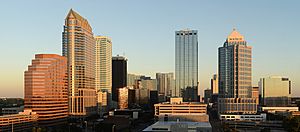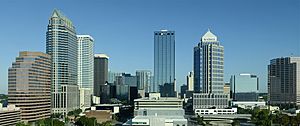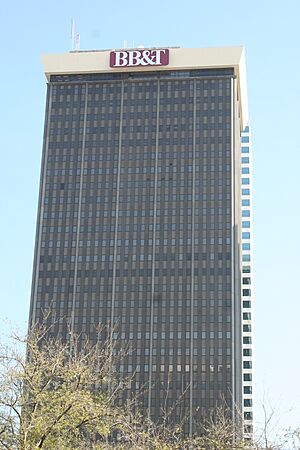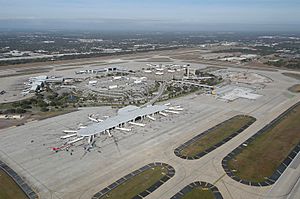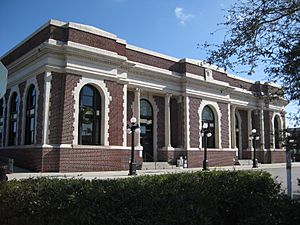Cityscape of Tampa, Florida facts for kids
The city of Tampa has many interesting buildings and historic areas. Two of the biggest historic neighborhoods are Seminole Heights and Hyde Park. These areas are protected to keep their old charm.
Contents
What are Tampa's Main Business Areas?
Tampa's main business area, called Downtown, is located next to the Hillsborough River. It's also southwest of the Ybor City Historic District. Downtown is home to many important places. These include the Tampa Theatre, the Tampa Museum of Art, and the Glazer Children's Museum. You can also find the Straz Performing Arts Center here.
Tampa International Airport is about 4 miles (6.4 km) northwest of downtown. It's easy to get to from most parts of the city. This is because three major highways connect to it. The city's biggest industrial areas are north of the airport and east of the city. Most homes are located southwest, northwest, northeast, and west of downtown.
Another big business area is the Westshore Business District. It is located near Tampa Bay and south of the airport. Westshore has many offices and nearly 100,000 employees. It also has 32 hotels and two large shopping malls. These malls are International Plaza and Bay Street and WestShore Plaza. Tampa has 165 parks, covering about 2,286 acres (9.25 km2).
What Kind of Architecture Does Tampa Have?
Tampa's buildings show a mix of old and new styles. Neighborhoods like Seminole Heights, Tampa Heights, and Hyde Park are historic areas. They mostly feature beautiful Victorian homes and buildings.
The Historic Tampa Bay Hotel
In 1891, Henry B. Plant built a very fancy hotel. It was called the Tampa Bay Hotel. This hotel had over 500 rooms and was about a quarter-mile (400 meters) long. It cost $2.5 million to build. The hotel was designed in a unique Moorish Revival style. It was set among 150 acres (61 ha) of beautiful gardens along the Hillsborough River.
Plant's hotel offered many amazing things. It had a race track, a heated indoor pool, and a golf course. There was also a large auditorium that could seat 2,000 people. Every room had electric lights and telephones. It even had the city's first elevator! Plant also brought in exotic art from all over the world.
The Tampa Bay Hotel was popular for about ten years. Many famous people stayed there. It was only completely full during the Spanish–American War. Henry Plant passed away in 1899. His family sold the hotel to the city of Tampa in 1904. The city ran the hotel and used its grounds for community events until 1932. Then, it was closed and remodeled. A year later, it reopened as the University of Tampa.
Exploring Tampa's Neighborhoods
The city of Tampa is made up of many different neighborhoods. Many of these used to be separate towns. Generally, Tampa is divided into several main areas. These include Downtown Tampa, New Tampa, West Tampa, East Tampa, North Tampa, and South Tampa.
East Tampa Communities
On the eastern side of the city, you'll find residential areas like College Hill and Jackson Heights-Belmont Heights. Ybor City, a historic area, is also in this district. Other neighborhoods include Southeast Seminole Heights and Grant Park. The industrial part of Gary is just east of downtown.
Davis Islands and Harbour Island
Besides the downtown business area, Tampa has two fancy neighborhoods. These are Davis Islands and Harbour Island. They are known for their beautiful homes.
South Tampa Communities
In the southern part of the city, there are neighborhoods like Ballast Point and Palma Ceia. Other areas include Bayshore Beautiful, Port Tampa, and New Suburb Beautiful. This region also includes parts of Sunset Park.
West Tampa Communities
The western part of the city has neighborhoods such as Armenia Gardens Estates and Beach Park. You can also find Carver City-Lincoln Gardens and Culbreath Isles here. The West Tampa District includes areas like MacFarlane Park and Old West Tampa. This region also has parts of Tampa Heights.
North Tampa and New Tampa
In the northern part of the city, you'll find neighborhoods like Forest Hills and Sulphur Springs. Temple Crest and University Square are also in this area.
The New Tampa district has its own special feel. It includes several upscale neighborhoods. These are Hunter's Green, West Meadows, and Tampa Palms.
Tampa's Tallest Buildings
Most of Tampa's tallest buildings are located in downtown. Here are some of them:
| Building | Height (meters) | Stories | Year Completed |
|---|---|---|---|
| 100 North Tampa | 176 | 42 | 1992 |
| Bank of America Tower | 176 | 42 | 1986 |
| One Tampa City Center | 164 | 38 | 1981 |
| SunTrust Financial Centre | 160 | 36 | 1992 |
| Element | 140 | 34 | 2009 |
| Park Tower | 140 | 36 | 1973 |
| Rivergate Tower (also known as the "beer can building") | 138 | 32 | 1988 |
Tampa's Skyline Views
How Do People Get Around Tampa?
Along Tampa's western shore, three bridges cross Old Tampa Bay. These bridges connect Tampa to Pinellas County. They are the Howard Frankland Bridge (I-275), the Courtney Campbell Causeway (SR 60), and the Gandy Bridge (US 92).
Tampa also has two main toll roads. The Lee Roy Selmon Expressway (SR 618) starts in Brandon and crosses into Tampa. It's a key road for people commuting to downtown. It continues down the South Tampa area.
The Veterans Expressway (SR 589) begins near Tampa International Airport. It connects to the Courtney Campbell Causeway. The Veterans Expressway goes north through suburbs like Carrollwood and Lutz. It then becomes the Suncoast Parkway, continuing into other counties.
Three Interstate Highways pass through Tampa. Interstate 4 starts where it meets Interstate 275. I-275 is a main road into the city from Pinellas County. It goes through downtown and neighborhoods like Seminole Heights. Interstate 75 also crosses through the New Tampa neighborhood.
Other important roads in the city include Hillsborough Avenue, Dale Mabry Highway, and Bruce B. Downs Boulevard.
Other Important City Structures
Airports in the Area
 Tampa International Airport (TPA) is Tampa's main airport. It's where most people fly in and out of the Tampa Bay area. In 2008, it was one of the busiest airports in North America. Travelers often rate it as one of the best airports.
Tampa International Airport (TPA) is Tampa's main airport. It's where most people fly in and out of the Tampa Bay area. In 2008, it was one of the busiest airports in North America. Travelers often rate it as one of the best airports. Peter O. Knight Airport (TPF) is a smaller airport. It's for private planes and is located on Davis Islands near downtown.
Peter O. Knight Airport (TPF) is a smaller airport. It's for private planes and is located on Davis Islands near downtown. Tampa Executive Airport (VDF) is another option for private planes. It's east of Tampa in Hillsborough County.
Tampa Executive Airport (VDF) is another option for private planes. It's east of Tampa in Hillsborough County. St. Petersburg-Clearwater International Airport (PIE) is across the bay from Tampa International. It's mostly for private planes but is becoming popular for discount airlines.
St. Petersburg-Clearwater International Airport (PIE) is across the bay from Tampa International. It's mostly for private planes but is becoming popular for discount airlines.
Railroads and Trains
The railroad system in Tampa was started by Henry Plant. Today, Uceta Rail Yard is still used by CSX for storing goods and moving containers. Cargo operations at the city's seaports also rely on train tracks near the docks.
Tampa's main train station for passengers is Tampa Union Station. It has been serving the city since 1912. This historic station is next to downtown, between the Channel District and Ybor City. Amtrak trains use it today. Amtrak's Silver Star train stops in Tampa twice a day. One train goes south to Miami, and the other goes north to New York City.
Union Station is also a hub for Amtrak bus connections. You can take a bus from here to several cities in Southwest Florida. You can also connect to Orlando for other train routes.
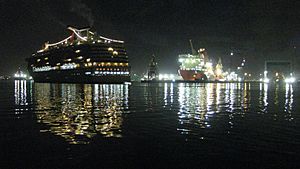
Tampa's Seaports
Sailors have admired Tampa Bay since Spanish explorers first saw it in the 1500s. However, the bay was naturally very shallow. This made it hard for large ships to reach the town of Tampa.
In 1899, the US Congress allowed a deeper channel to be dug to Port Tampa. This was Henry Plant's facility for moving goods from trains to ships. In 1917, another channel was dug to the main Port of Tampa. This quickly made Tampa an important shipping location.
The bottom of the bay is very sandy. The ship channels need to be constantly dredged to keep them deep enough for large modern cargo ships. Every year, a huge amount of sand is removed from the bay.
Today, the Port of Tampa is the biggest port in Florida for the amount of goods it handles. This makes it one of the busiest commercial ports in North America. Oil and phosphate are the main goods shipped through the port. They make up two-thirds of the 37 million tons of cargo handled in 2009.
The Tampa Port Authority also runs three cruise ship terminals. These are in Tampa's Channel District. The Port of Tampa is a home port for Carnival Cruise Lines' ships like the MS Carnival Inspiration. Other cruise lines like Holland America Line and Royal Caribbean International also use Tampa as a seasonal home port. Cruises from Tampa visit islands in the Eastern and Western Caribbean, Belize, and Mexico.
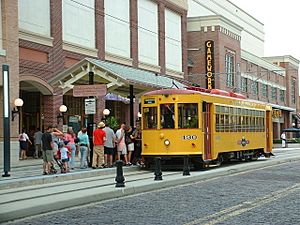
Public Transportation
Public transportation in Tampa is run by the Hillsborough Area Regional Transit Authority (HART). This includes a public bus system and a streetcar line. Students from the University of South Florida can ride most bus routes for free. Students from other schools can get discounted fares.
In October 2002, the TECO Line Streetcar brought electric streetcar service back to Tampa. This was the first time in over 50 years! The streetcar line has ten stations and is about 2.4 miles (3.9 km) long. It connects Ybor City, the Channel District, the Tampa Convention Center, and downtown Tampa. An extension to Franklin Street was finished in December 2010.
The TECO line cars look old-fashioned, with wooden interiors. But they are modern inside! They are wheelchair accessible and have air conditioning. This makes them comfortable for people riding in Tampa today.


